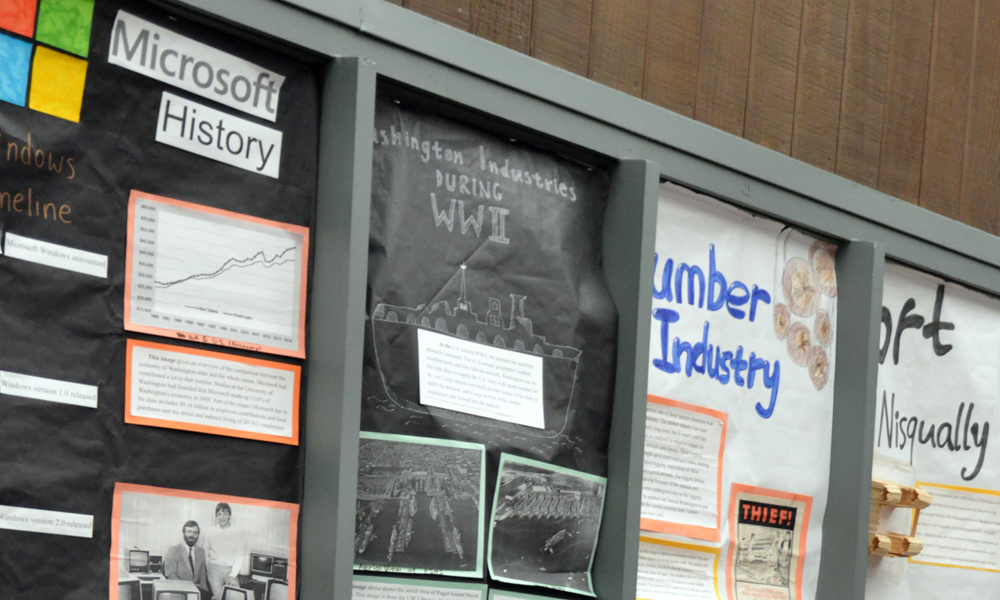Learning to Think Like A Historian
By Nikki Fastlee
Experiential, place-based, and project-based learning are hot buzz words in the realm of education right now, and rightly so. They provide students with ownership of their learning, connect students to experts in the field, and immerse students in an environment directly associated with what they are studying. We were lucky enough to have the opportunity to redesign the 9th Grade Historical Writing curriculum this last summer to incorporate these interactive components through a focus on Washington State History.
The CWA community is fortunate to reside in an area that is rich with Washington State historical resources. It is all over! We have the unique opportunity to be near experts, like historians at the Washington State History Museum, librarians at the Tacoma’ Public Library’s Northwest Room, and staff at HistoryLink, Washington State’s online historical encyclopedia.
After studying the timeline of Washington’s history to get a broad insight into the events of Washington’s past, we partnered with History Link. Students had the opportunity to video chat with Assistant Director Jennifer Ott to ask questions about oral histories and then they conducted their own interview, writing an oral history that was submitted to Ott and her editors at History Link. This opportunity to speak to a professional historian provided students with skills that helped them to conduct interviews with a family member, teacher, or neighbor about their experience of an event in Washington State’s history. Students were nervous to interview someone, but it taught them valuable skills about how to have a professional conversation in addition to writing for a broader audience than just their teachers.
After this engaging project, students began additional research by exploring the resources available at the CWA libraries, reviewing topics that they had already learned a little about from their oral history collection, and reading their textbook. Students were allowed to pick any topic from Washington’s past that interested them. This topic would become their subject matter for the rest of the trimester. Giving students the freedom to select a topic that they were invested in and curious about was paramount. They spent about a month and a half on the project exploring, researching, organizing, and eventually writing an essay. Their job, with guidance, was to find the answer to their research question and claim a profound intellectual argument about their question, proving its legitimacy in essay form.
Once students selected their focus and wrote a preliminary research question we took a field trip to visit experts and find unique sources right here in our own backyard. Here is where our place-based learning came into play. We traveled to downtown Tacoma and started out at the Washington State History Museum on Pacific Avenue. We had the opportunity to talk to the curator of the museum, Gwen Whiting, about how she and the historians working at the museum gather information and design museum exhibits. This information and the exploration students did at the museum would come into play at the end of the project, when students collaborated to make a Washington State History Museum Installation in the Upper School atrium.

The group continued on an exploration of knowledge to the Northwest Room, located at the Main Branch of the Tacoma Public Library. This enormous and beautiful room, the original 1903 Carnegie Library, houses collections and services that are dedicated to providing comprehensive and accessible local and regional history information to the public. The collections feature everything from Tacoma city directories dating back to 1885, early to current newspapers, record indexes, maps, photos, postcards, manuscript collections, architectural plans, and much more. This was a gold mine for students and a historian’s dream. The opportunity our students had to get their hands on documents from the time period they were studying is something they may never do again. They were detectives, searching for the right information to try and answer their questions, sleuthing through newspaper clippings from 1901, looking at maps of Seattle and Tacoma, and noticing the boom of industrialization that occurred along the waterways in both major cities. They discovered evidence of the acceptance and prejudice shown towards immigrants here in our own town and along the West Coast. Students were learning, and they were invested.
The engagement that students had in this project and their yearning to find the answer to their question was inspiring as an educator. It was not always easy. In fact, as we headed back to school and continued our research with online databases, some students noticed that they had not collected as much information as they should have on our field trip. Or the opposite occurred: they had too much and had trouble sorting through it. Students even found that the information they collected did not answer their question, or the answer they found was not what they expected. These are great struggles; they allow students to wrestle with the process of learning, and the challenges that come with research and writing. Throughout this trimester our students in Historical Writing: Washington State History were able to experience learning in practical ways and have ownership of their curiosity. Through this large and involved project, we were all able to experience the place we live in, both in the past and present, learning and discovering our passions and interests. That is what those buzzwords are about, and I look forward to reflecting and tweaking the course for our next group of young minds waiting to explore.

